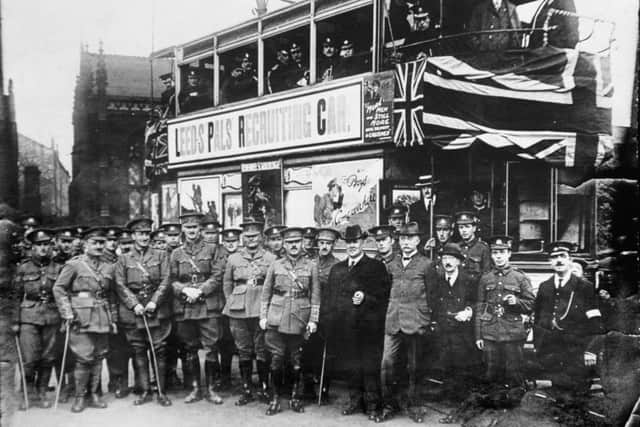Armistice 100. Pals who answered call to arms
The recruitment campaigns that gathered pace in every corner of the British Isles after the onset of the First World War left little room for dissent.
“Who’s absent?” demanded a John Bull figure in top hat and Union Jack waistcoat, pointing from the centre of one of the Government’s posters. “Is it you?”
Advertisement
Hide AdAdvertisement
Hide AdThe implication was clear. Those who demurred were to be considered unpatriotic pariahs.


The pressure came not only from above. To serve King and Country was an expectation, an honour even, among peer groups.
That was the climate, clinging to Victorian subservience, that gave rise to the uniquely British phenomenon of the Pals battalions which sprang up across Yorkshire and beyond.
In a wave of patriotic fervour, fuelled by the realisation that Britain’s 700,000 professional soldiers would be outnumbered fivefold by the German war machine, men volunteered in their thousands for Lord Kitchener’s new armies. They came not just as individuals but in the company of their friends, relatives and workmates.
Advertisement
Hide AdAdvertisement
Hide AdThe first Pals battalion was formed a month into the war, from stockbrokers in the City of London, but it was the North of England with which such units became synonymous. Men from Leeds, Bradford, Grimsby, Barnsley, Hull, Sheffield and across the region enlisted en masse. By mid-1915 they were beginning to arrive on the Western Front.
A photograph of infantrymen from 10th Battalion, East Yorkshire Regiment – the Hull Pals – shows them smiling for the camera as they pass by, three days before the commencement of the Battle of the Somme.
Their camaraderie and optimism is plain to see. But they were lambs to the slaughter. Within days, they were being cut down in their hundreds. Some 1,770 Pals from Bradford died in a single hour, as they attacked the heavily fortified village of Serre.
Of 900 members of the 15th (Service) Battalion West Yorkshire Regiment – the Leeds Pals – around 750 lost their lives.
Advertisement
Hide AdAdvertisement
Hide AdThe impact on the communities back home was intense and incalculable.
Nor were the casualties confined to men of fighting age, if such an age existed. The law defined it as 19 for overseas service, but at least a quarter of a million were younger.
Around half of them were killed, wounded or taken prisoner. They had not been coerced to enlist – although recruitment officers sometimes turned a blind eye in order to earn their half-crown for each man they signed– but had gone willingly. Some were swept away by peer pressure, to which teenagers were as susceptible then as now, others to escape from workaday lives that held out little promise.
The notion that war was a glamorous alternative to the class-ridden society at home had not yet been washed away by the blood spilled on the Western Front.
Advertisement
Hide AdAdvertisement
Hide AdIt was not until 1916 that the War Office announced that if parents could prove that their son was underage, they could ask for them to be sent back.
The aberrations of the boy soldiers and the Pals regiments were never to be replicated. In 1916, the close-knit nature of the Pals battalions was subsumed by the introduction of universal conscription.
By war’s end the Allies had recorded six million deaths, the Quadruple Alliance of Germany, Austria-Hungary, the Ottoman Empire and Bulgaria, four million more. In total, some 16 million perished in what had been one of the deadliest conflicts in human history. Just 21 years later, the world was at war again.